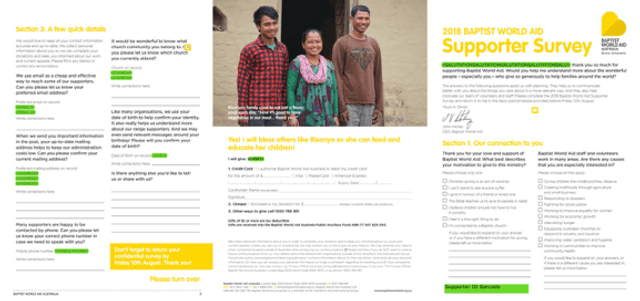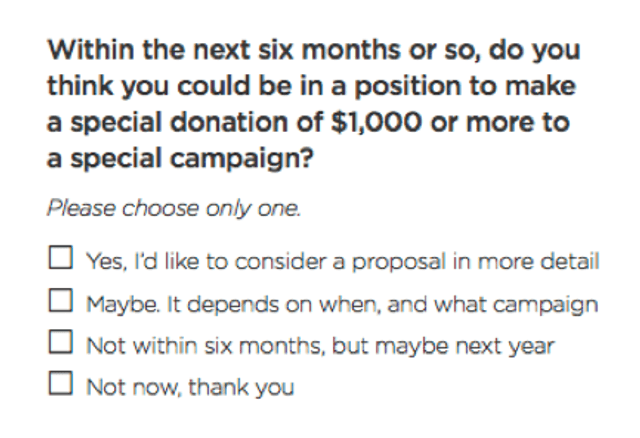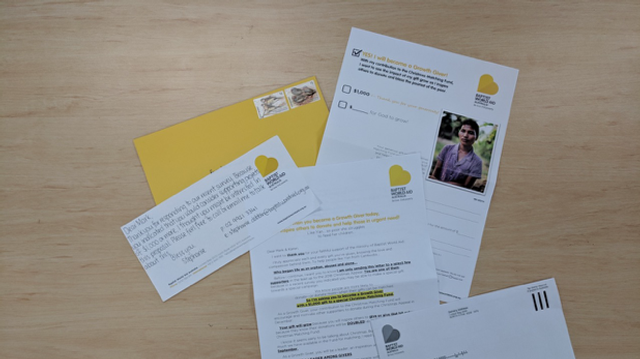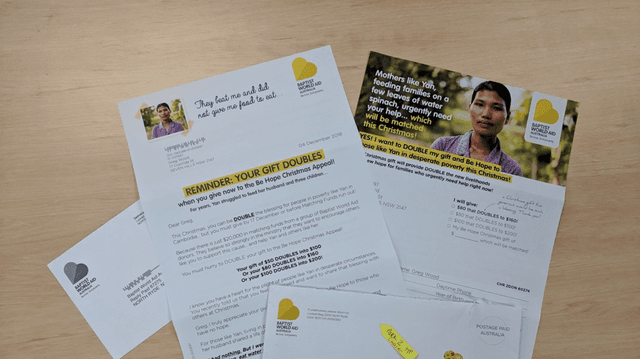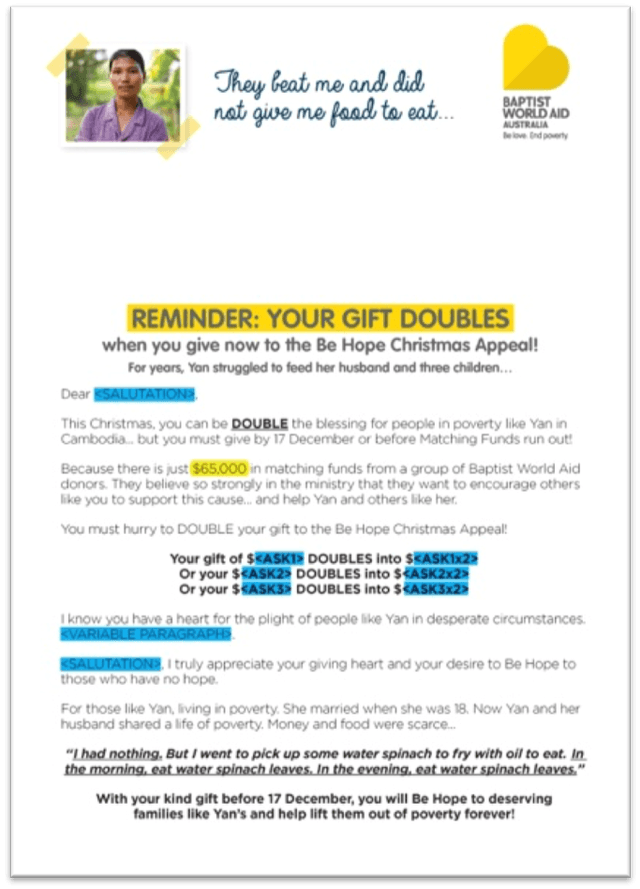Baptist World Aid Australia: Growth Giver
- Exhibited by
- Fiona McPhee
- Added
- February 20, 2020
- Medium of Communication
- Letter, appeal
- Target Audience
- Mid-value donors
- Type of Charity
- Christian, international development
- Country of Origin
- Australia
- Date of first appearance
- 2018
SOFII’s view
Who can argue with results like these? In this detailed case study by Fiona McPhee we see how Baptist World Aid Australia (BWAA) embarked on a thoughtful, but not risk-averse, strategy to concentrate on mid-value leads and convert them into regular mid-value givers.
The pack featured a beautiful donor-centred design and clear, insightful messaging that was based on well-researched survey results. As a result, BWAA smashed expectations and created a wonderful unique selling point: turning donors into Growth Givers. And they did all of that in just four months. It’s no wonder Fiona’s analysis of this campaign was a highlight of our I Wish I’d Thought of That (IWITOT) session at the International Fundraising Conference (IFC) in 2019.
Summary / objectives
BWAA needed to grow revenue for their Christmas appeal, a key campaign in the calendar each year. With acquisition costs skyrocketing and response rates dropping, the swing from acquisition to a focus on the potential within the retained donor base was essential. BWAA identified the mid-value giving space as holding potential for them and looked to use personalisation and targeting the right people at the right time to engage and increase results over the previous Christmas period. Fortunately, they were also willing to take some calculated risks and follow through on these. BWAA spent much more than the previous year in order to make more. They increased engagement, communicating more than twice as much with donors as the previous year.
To summarise, the objectives were to:
- obtain motivational responses from donors to allow for personalisation
- identify mid-value leads
- convert leads to mid-value givers
- increase the response and average gift to Christmas appeal over the previous year
Background
In 2018 BWAA mailed a supporter connection survey to their donors. They had a great response to a question that asked donors if they would be interested in making a gift of more than AUD$1,000 (the start of the middle donor/mid-value range).
BWAA wanted to follow up quickly with these donors, but had limited resources (they couldn’t phone them or visit). As such, BWAA decided to send a special appeal. The appeal asked the donors to become a Growth Giver and make a gift to a fund that would be used to match donations made during the upcoming Be Hope Christmas appeal.
Special characteristics
The main reason this appeal did so well is that it was a compelling offer presented to very well-qualified group of donors.
Offer: Match offers are powerful. And while the Growth Giver ask was sort of a ‘reverse’ match, asking the donor to supply the matching funds rather than the typical ‘get your gift matched’ – it was just as effective as a typical match offer.
Donors: Remember, a few weeks before, BWAA asked this very group if they'd be interested in giving a gift of AU$1,000 or more. The people who said ‘no’ didn't receive this Growth Giver appeal (integrating direct mail and e-mail). BWAA were asking the selected target audience to do something they said they'd be interested in doing.
The average gift was AU$1,035 – the donors really did mean it when they said they would be interested in making a bigger gift (a gift of AU$1,000 or more)! One donor gave AU$6,000 when their previous highest gift was AU$350.
The response rate was 24 per cent – this is close to five times higher than the response rate BWAA sees to a standard appeal.
The outer envelope was bright yellow. There was no teaser, and it was hand-addressed. That's a potent combination of proven direct response fundraising techniques.
BWAA made the act of giving feel larger than life by using copy in the Growth Giver appeal like:
- You will be a leader among givers
- You will be an inspiration to others to give
- You will be a blessing to the poorest
Crucially the organisation also names anyone who gives a Growth Giver. It's not just a donation, it's a social act. It created a sense of community.
Even though it mailed quite a long time before Christmas, BWAA really focused on the holiday, calling the fund they wanted donors to make possible the Christmas Matching Fund. Christmas is a powerful motivator for many donors.
The letter was repetitive. Even a skimmer will get the point they want to make! The letter was full of donor benefits – what’s in it for you when you give!
Included in the letter was a story about someone who will be helped by the campaign (Yan). Yan's story represents the need and solution donors were being asked to be part of. Critically the story was balanced with what the match would mean for the donor – the offer to become a Growth Giver. Balancing two offers can be hard to do when you've got a good story to tell, (and fundraising best practice tells us focus on a single compelling offer for best results) but BWAA managed that balance successfully.
There was also a photo of Yan, looking sombre and serious. It can be tempting to use a pleasant, smiling image (and they had several), but the photo shouldn't undermine the need.
Finally, there was a handwritten insert from a real person, the BWAA team member who was responsible for the relationship development with the Growth Givers – the mid-value donors prospects. This did a great job connecting the donor to the cause, the campaign itself, and their previous answer on the survey that they might be willing to give this special gift.
The subsequent Be Hope Christmas Appeal gave donors the opportunity to have their donation doubled by a match from the Christmas Matching Fund created by the Growth Givers.
BWAA found that donors responded strongly to this campaign because it utilised the matched giving offer, a strong proposition, storytelling and best practice direct response tactics. These tactics included:
- personalised ask amounts for each donor
- variable copy depending on information provided in the survey, such as what type of donor they were
- handwritten outer envelopes and personalised notes for higher-value donors
- a reminder mailing to those most likely to respond
- integrating email where appropriate based on donor preferences and availability of email
This appeal delivered higher response rates and average gifts than the previous year, delivering much higher net income available for the cause.
Creator / originator
Baptist World Aid Australia
Merits
A three-stage campaign that generated mid-value donor leads and converted these leads to mid-value level giving. The appeal drove response and income to the subsequent Be Hope Christmas Appeal by leveraging a matched giving concept.
As an aside, it should be noted that the BWAA team pulled this three-stage campaign together and executed it in just four months. They learned a great deal from this appeal and applied those findings to a roll out in 2019.
Results
The initial survey had multiple objectives and was sent out to a variety of audiences. One of those objectives was to identify 60 mid-value leads and, crucially, it generated 364. The very same survey also generated AU$21,945 in donations (this was AU$12,055 in the red).
Of the above 364 leads, 279 were deemed viable and were mailed the Growth Giver pack. With a 24 per cent response rate the 67 respondents generated a AU$66,500 Christmas Matching Fund (this is the net available for the fund after costs). The Growth Giver mailing also upgraded 23 donors to BWAA’s mid-value level, six donors gave more than the AU$1,000 ask, including one long-term loyal supporter whose previous highest gift was AU$350, gave AU$6,000.
The Be Hope Christmas Appeal delivered an 11 per cent response rate (up eight per cent on the previous year’s similarly targeted campaign) and generated AU$251,000 net revenue which was 24 per cent up on the previous year.
Both the Growth Giver and Be Hope Christmas Appeals were incredibly successful – as a combined programme survey + Growth Giver + Be Hope income was 61 per cent higher than the previous year and over 20 mid-value donors were identified and engaged in further cultivation. Overall the survey + Growth Giver + Be Hope raised AU$317,000 net vs. AU$196,000 net raised the previous year.
Also in Categories
-



